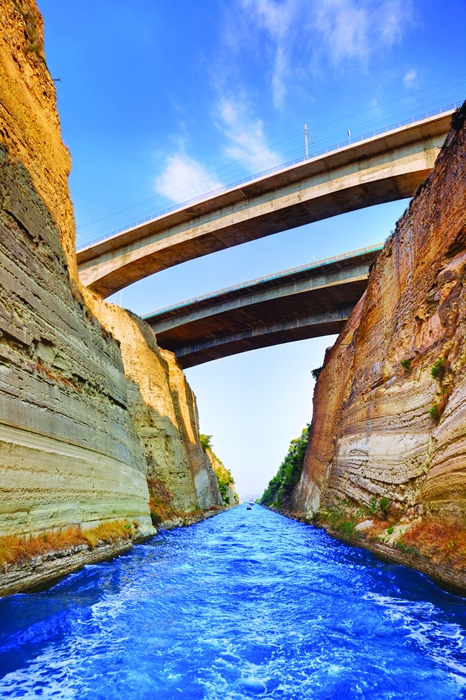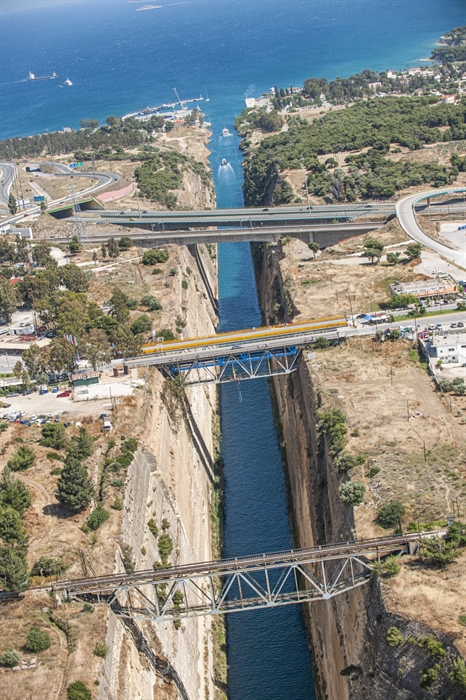The Corinth Canal
Awe! This is the feeling you get if you stand long over the Corinth Canal, with the high and vertical “walls”. In the background, an oblong strip of water, in dark blue. Here the Corinthian Gulf reconciles with the Saronic Gulf, and so do the Aegean and Ionian Sea.
Awe! This is the feeling you get if you stand long over the Corinth Canal, with the high and vertical “walls”. In the background, an oblong strip of water, in dark blue. Here the Corinthian Gulf reconciles with the Saronic Gulf, and so do the Aegean and Ionian Sea.
Ships of all nationalities used to cross the canal, and still do up to our day. They are like a multinational “parade” crossing a canal 8 meters deep, measuring 6,343 m long by 24.6 m wide at sea level, and 21 m wide at the bottom. If you get the chance to see the daredevils do bungee jumping at the Isthmus, the spectacle will... blow your mind!
A random geological fact, the narrow part of land, connecting Central Greece with the Peloponnese, making the ships take long and dangerous trips, became a riddle to be solved as early as the 7th century BC. The first to think of the canal around 620 BC was Periander, the tyrant of Corinth, and among the 7 Sages of Greece. Eventually, he opted for the construction of Diolkos, a road symmetrically covered with large stone cubes, along which ships could be towed from one side of the isthmus to the other, on carriages (olkoi). Thus, he handed... the baton of the canal plan to his successors: Demetrius Poliorcetes, Julius Caesar, Caligula, Gaius, Hadrian. Every time, the project would be abandoned.
This is where infamous Nero enters the story. In 66 AD, after watching the Isthmian Games, he thought of a canal design. In 67 AD, he triumphantly inaugurated the project, to the sounds of trumpets. Thousands of workers were employed, but they never completed it. Nero returned to Rome, and after his murder, the construction ceased. Nevertheless, the traces of the cutting, at a length of 3,300m, remained.
He was succeeded by Herodes Atticus and Byzantine Greeks, Venetians in 1687, but in vain.
In the newly formed Greek state, governor Ioannis Kapodistrias incorporated the cutting project into the overall infrastructure projects. However, he was murdered before anything happened. When the Suez Canal was constructed in 1869, the government of Prime Minister Zaimis, decided to cut the Isthmus, but due to lack of money, the canal wasn’t constructed until 1881.
Hungarian István Türr undertook then its construction and operation for the next 99 years. Construction began in 1882. Nero...reemerged! Centuries later, they followed his cutting design at a length of 6,300 m as more economical and correct. However, the company went bankrupt in 1889.
Construction eventually resumed, and was completed after 1893, when Charilaos Trikoupis was Prime Minister. The project was transferred to “Company of the Canal of Corinth”, under Andreas Syngros, banker and benefactor.
In 1944, as German forces retreated from Greece, they caused major landslips, which blocked the canal, not allowing the ships to cross. Funded by Marshall Plan, the canal reopened in October of 1947, and from 1948 onwards ships smaller in size and capacity started to cross.
(Facts about the history of the Corinth Canal have been sourced from https://aedik.gr and the book of the prefectoral authority of Corinth “Natural environment, history, monuments, ecological and cultural routes”).
Bungee jumping and falls full of adrenaline!
An extreme experience and a unique feeling of freedom. A fall into the void, eyes wide open, from a height of 80 meters. The vertical walls of the Isthmus surround you, and in the background you can see the canal with the dark coloured waters. If you are lucky enough, you may see a ship crossing.
The Isthmus of Corinth is an international destination for bungee jumping enthusiasts. The platform lies on the bridge of the original Greek National Road, at the exit for Loutraki. You can turn to the certified bungee jumping company.
The experienced pilot Péter Besenyei, instigator of Red Bull Air Race championship, achieved in 2017 something unprecedented in the history of the Isthmus, by flying in his special one-seat plane through the canal walls, performing all sorts of dangerous manoeuvres!
Submersible bridges
Central Greece and the Peloponnese are also connected through the Posidonia and Isthmia submersible bridges. The former, reduces the distance between Loutraki and Corinth, sinks to 11 m, and it is the end of the Isthmus on the side of the Corinthian Gulf. Open the camera app and wait for the next ship to cross. The spectacle is majestic.
Did you know that
The area of the Isthmus was a very strategically important location throughout the centuries, a place of conflict and dispute. In Antiquity, Greeks gathered here three times, under common leadership, in order to deal with external risks (Persian Wars), or in order to campaign against Persia (Philipp and Alexander the Great).
Thanks to the opening of the canal, the sailing distance between Piraeus and Italy was greatly reduced.
The distance between Patras and Piraeus is 100 nautical miles, via the canal. The round of Peloponnese is 295 nautical miles.
Two road bridges and two railway bridges at the Isthmus link Central Greece with the Peloponnese.
See details about the Canal here
Location
Find the destination on the interactive map below.
Categories
Weather
Σχετικό περιεχόμενο χρηστών (UGC)
Ενημερωθείτε για ενδιαφέροντα θέματα γύρω από τον προορισμό μέσα από το περιεχόμενο των χρηστών μας
Discover 7 hidden gems of the Peloponnese
Many of you may have already visited some of the most renowned attractions…
TOP 10 archaeological museums in the Peloponnese
Olympia, Mycenae, Epidaurus, Diros Cave, Ancient Corinth, Messene and…
TOP 10 Castles in the Peloponnese
Castles galore! Mystras, Monemvasia, Palamidi, Methoni, Koroni,…
Newsletters
- About us
- FAQ's
- Map
- Tourism information centers
- Disclaimer
- Sitemap
- Our brand
- Media roum
- Adding your bussiness
- Corporate
- MICE

Peloponnese. Greece beyond the obvious





Design and creation from Cosmote
Marinas and Moorings
Diving centers
Get inspired
- Media gallery
- Blog
- The Peloponnese in the media
- Your feedback
- Users' general content
- Users' local products
- Users' events content
- Ask a local
More
- Accommodation
- Travel agencies
- Restaurants
- Services
- Destinations Map
- Weather
- Public transport
- Events
- Frequently asked questions
- Useful phones
- B2B
- Destination Data
- Contact



